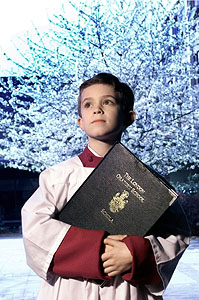Mixing White Balances
 We’ve all seen cross processing and the interesting colours that it gives, but I like to play about with colour temperatures too. Digital allows you to switch from daylight to fluorescent, back to daylight and on to tungsten without having to reload film.
We’ve all seen cross processing and the interesting colours that it gives, but I like to play about with colour temperatures too. Digital allows you to switch from daylight to fluorescent, back to daylight and on to tungsten without having to reload film.
The choirboy was standing inside the chapel where there was a lot less light than outside, where the meter reading was 1/250th of a second at f16 on the 200 asa setting.
1.The camera was set to the tungsten pre-set white balance, and an 85b filter was placed over the Lumedyne flash head with a softener over the reflector. These filters are also called “full CT orange” and you can buy them by the sheet manufactured by companies such as Rosco and Lee Lighting
2. The power was set at maximum with the flash about seven feet away at an angle of 45°. The flash was at an elevation of 30° above the boy’s eyeline.
3. A quick test shot showed that the flash needed to be moved a little closer to the chorister to get the f22 required to expose him and under expose the background by a stop.
And that’s about it. The outdoors goes blue, and the subject is the right colour. An interesting technique that is quick and simple. The digital’s LCD screen allows you to balance foregound and background simply.
